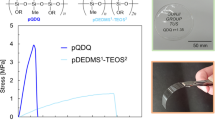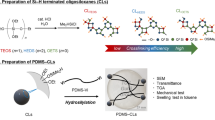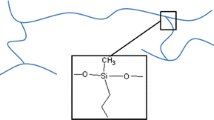Abstract
Stable DQ silicone polymer sols composed of di (D)- and tetra (Q)-functional alkoxysilanes were prepared by the following methods: (i) co-hydrolysis–condensation between diethoxy(dimethyl)silane (DEDMS) and tetraethoxysilane (TEOS) (DEDMS–TEOS as random copolymer sols), (ii) co-hydrolysis–condensation between poly(dimethylsiloxane) (PDMS) and TEOS (PDMS–TEOS as random block copolymer sol), and (iii) triethoxysilylation of a PDMS-lithium salt (PDMS–TES). The polymer sols were characterized by GPC, NMR, and FT-IR. The differences in properties between the structures were analyzed from their thermal stabilities and by using the swelling test. Thermal stabilities of these polymer sols were increased with the increase in the chain length of the D domain and with decrease in hydrolyzability. The swelling of films via polymer sols was decreased with the increase in the degree of crosslinking in sols.

DQ silicone polymer sols were prepared by three different methods and characterized by NMR, FT-IR, and GPC. The thermal stabilities of these sols were increased with the increase of the chain-length of D unit and hydrolysis resistance. Also, the solvent uptake was increased with the decrease of the degree of crosslinking in sols
Highlights
-
DQ silicone sols with different content and length of D units were prepared by using two methods.
-
Triethoxysiloxyl-terminated PDMS of higher molecular weight was prepared.
-
The structures of these polymer sols were characterized by 29Si NMR spectra.
-
The differences in properties of the structures were evaluated from their thermal stabilities and by using the swelling test.








Similar content being viewed by others
References
Mayer H (1999) The chemistry and properties of silicone resins. Surf Coat Int 82:77–83
Loy DA, Baugher BM, Baugher CR, Schneider DA, Rahimian K (2000) Substituent effects on the sol–gel chemistry of organotrialkoxysilanes. Chem Mater 12:3624–3632
Sinkό K (2010) Influence of chemical conditions on the nanoporous structure of silicate aerogels. Materials 3:704–740
Azlina HN, Hasnidawani JN, Norita H, Surip SN (2016) Synthesis of SiO2 nanostructures using sol–gel method. Acta Phys Pol A 129:842–844
Loy DA, Shea KJ (1995) Bridged polysilsesquioxanes. highly porous hybrid organic–inorganic materials. Chem Rev 95:1431–1442
McDonagh C, Sheridan F, Butler T, MacCraith BD (1996) Characterisation of sol–gel-derived silica films. J Non-Cryst Solids 194:72–77
Coradin T, Boissiére M, Livage J (2006) Sol–gel chemistry in medicinal science. Curr Med Chem 13:1–10
Narisawa M (2010) Silicone resin applications for ceramic precursors and composites. Materials 3:3518–3536
Gunji T, Makabe Y, Takamura N, Abe Y (2001) Preparation and characterization of organic–inorganic hybrids and coating films from 3-methacryloxypropylpolysilsesquioxane. Appl Organomet Chem 15:683–692
Takamura N, Gunji T, Hatano H, Abe Y (1999) Preparation and properties of polysilsesquioxanes: polysilsesquioxanes and flexible thin films by acid-catalyzed controlled hydrolytic polycondensation of methyl- and vinyltrimethoxysilane. J Polym Sci A 37:1017–1026
Abe Y, Kagayama K, Takamura N, Gunji T, Yoshihara T, Takahashi N (2000) Preparation and properties of polysilsesquioxanes. Function and characterization of coating agents and films. J Non-Cryst Solids 261:39–51
Gunji T, Iizuka Y, Arimitsu K, Abe Y (2004) Preparation and properties of alkoxy(methyl)silsesquioxanes as coating agents. J Polym Sci A 42:3676–3684
Takamura N, Okonogi H, Gunji T, Abe Y (2000) Preparation and properties of polysilsesquioxanes —preparation and properties of polymer hybrids from vinyltrimethoxysilane—. Kobunshi Ronbunshu 57:198–207
Abe Y, Gunji T (2004) Oligo- and polysiloxanes. Prog Polym Sci 29:149–182
Abe Y, Shimano R, Arimitsu K, Gunji T (2003) Preparation and properties of high molecular weight polyethoxysiloxanes stable to self-condensation by acid-catalyzed hydrolytic polycondensation of tetraethoxysilane. J Polym Sci A 41:2250–2255
Gunji T, Tozune T, Kaburaki H, Arimitsu K, Abe Y (2013) Preparation of co-polymethyl(alkoxy)siloxanes by acid-catalyzed controlled hydrolytic copolycondensation of methyl(trialkoxy)silane and tetraalkoxysilane. J Polym Sci A 51:4732–4741
Gunji T, Kaburagi H, Tsukada S, Abe Y (2015) Preparation, properties, and structure of polysiloxanes by acid-catalyzed controlled hydrolytic co-polycondensation of polymethyl(methoxy)siloxane and polymethoxysiloxane. J Sol–Gel Sci Technol 75:564–573
Yuan QW, Mark JE (1999) Reinforcement of poly(dimethylsiloxane) networks by blended and in-situ generated silica fillers having various sizes, size distributions, and modified surfaces. Macromol Chem Phys 200:206–220
Chen D, Chen F, Hu X, Zhang H, Yin X, Zhou Y (2015) Thermal stability, mechanical and optical properties of novel addition cured PDMS composites with nano-silica sol and MQ silicone resin. Compos Sci Technol 117:307–314
Uilk J, Bullock S, Johnston E, Myers SA, Merwin L, Wynne KJ (2000) Surface science of elastomeric coatings prepared from α,ω-dihydroxypoly(dimethylsiloxane) and the ethoxysiloxane mixture”ES40”. Macromolecules 33:8791–8801
Babonneau F (1994) Hybrid siloxane-oxide materials via sol–gel processing: structural characterization. Polyhedron 13:1123–1130
Hyeon-Lee J, Guo L, Beaucage G, Macip-Boulis MA, Yang AJM (1996) Morphological development in PDMS/TEOS hybrid materials. J Polym Sci B Polym Phys 34:3073–3080
Guo L, Hyeon-Lee J, Beaucage G (1999) Structural analysis of poly(dimethylsiloxane) modified silica xerogels. J Non-Cryst Solids 243:61–69
Huang H-H, Orler B, Wilkes GL (1987) Structure-property behavior of new hybrid materials incorporating oligomeric species into sol–gel glasses. 3. Effect of acid content, tetraethoxysilane content, and molecular weight of poly(dimethylsiloxane). Macromolecules 20:1322–1330
Iwamoto T, Morita K, Mackenzie JD (1993) Liquid state 29Si NMR study on the sol–gel reaction mechanisms of ormosils. J Non-Cryst Solids 159:65–72
Wen J, Mark JE (1995) Sol–gel preparation of composites of poly(dimethylsiloxane) with SiO2 and SiO2/TiO2, and their mechanical properties. Polym J 27:492–502
Babonneau F, Thorne K, Mackenzie JD (1989) Dimethyldiethoxysilane/tetraethoxysilane copolymers: Precursors for the silicon-carbon-oxygen system. Chem Mater 1:554–558
Zhu B, Katsoulis DE, Keryk JR, McGarry FJ (2000) Toughening of a polysilsesquioxane network by homogeneous incorporation of polydimethylsiloxane segments. Polymer 41:7559–7573
Armarego WLF, Chai C (2012) Purification of Laboratory Chemicals, 7th edn. Butterworth-Heinemann, Oxford, UK
Fei H-F, Xie W, Wang Q, Gao X, Hu T, Zhang Z, Xie Z (2014) Controlled synthesis and characterization of poly[methyl(3,3,3-trifluoropropyl)siloxane] with selective end groups. RSC Adv 4:56279–56287
Kazakova VV, Gorbatsevich OB, Skvortsova SA, Demchenko NV, Muzafarov AM (2005) Synthesis of triethoxysilanol. Russ Chem Bull Int Ed 54:1350–1351
Hayami R, Wada K, Nishikawa I, Sagawa T, Tsukada S, Yamamoto K, Gunji T (2017) Preparation and properties of organic–inorganic hybrid materials using titanium phosphonate cluster. Polym J 49:665–669
Sakka S, Tanaka Y, Kokubo T (1986) Hydrolysis and polycondensation of dimethyldiethoxysilane and methyltriethoxysilane as materials for the sol–gel process. J Non-Cryst Solids 82:24–30
Julián B, Gervais C, Cordoncillo E, Escribano P, Babonneau F, Sanchez C (2003) Synthesis and characterization of transparent PDMS–metal-oxo based organic–inorganic nanocomposites. Chem Mater 15:3026–3034
Téllez L, Rubio J, Rubio F, Morales E, Oteo JL (2003) Synthesis of inorganic–organic hybrid materials from TEOS, TBT and PDMS. J Mater Sci 38:1773–1780
Mansur HS, Oréfice RL, Mansur AAP (2004) Characterization of poly(vinyl alcohol)/poly(ethylene glycol) hydrogels and PVA-derived hybrids by small-angle X-ray scattering and FTIR spectroscopy. Polymer 45:7193–7202
Andrade GI, Barbosa-Stancioli EF, Mansur AAP, Vasconcelos WL, Mansur HS (2008) Small-angle X-ray scattering and FTIR characterization of nanostructured poly (vinyl alcohol)/silicate hybrids for immunoassay applications. J Mater Sci 43:450–463
Almeida JC, Castro AGB, Lancastre JJH, Salvado IMM, Margaҫa FMA, Fernandes MHV, Ferreira LM, Casimiro MH (2014) Structural characterization of PDMS–TEOS–CaO–TiO2 hybrid materials obtained by sol–gel. Mater Chem Phys 143:557–563
Molenberg A, Möller M (1995) A fast catalyst system for the ring–opening polymerization of cyclosiloxanes. Macromol Rapid Commun 16:449–453
Levy D, Zayat M (2015) The Sol–Gel Handbook: Synthesis, Characterization, and Applications, 1st edn. Wiley-VCH, Weinheim, Germany
Fuchise K, Igarashi M, Sato K, Shimada S (2018) Organocatalytic controlled/living ring–opening polymerization of cyclotrisiloxanes initiated by water with strong organic base catalysts. Chem Sci 9:2879–2891
Ibemesi JA, Meier DJ (1979) Synthesis of block copolymers of methyl siloxane, phenyl siloxane, vinyl siloxane, etc. Report 11:8, https://www.osti.gov/scitech/servlets/purl/5296016-koHrfB
Zhang Y, Zhang Z, Wang Q, Xie Z (2007) Synthesis of well-defined difunctional polydimethylsiloxane with an efficient dianionic initiator for ABA triblock copolymer. J Appl Polym Sci 103:153–159
Yashiro T, Kricheldorf HR, Schwarz G (2010) Polymerization of cyclosiloxanes by means of triflic acid and metal triflates. Macromol Chem Phys 211:1311–1321
Prado LASA, Sforça ML, de Oliveira AG, Yoshida IVP (2008) Poly(dimethylsiloxane) networks modified with poly(phenylsilsesquioxane)s: synthesis, structural characterization and evaluation of the thermal stability and gas permeability. Eur Polym J 44:3080–3086
Gun’ko VM, Borysenko MV, Pissis P, Spanoudaki A, Shinyashiki N, Sulim IY, Kulik TV, Palyanytsya BB (2007) Polydimethylsiloxane at the interfaces of fumed silica and zirconia/fumed silica. Appl Surf Sci 253:7143–7156
Thomas TH, Kendrick TC (1970) Thermal analysis of polysiloxanes. II. Thermal vacuum degradation of polysiloxanes with different substituents on silicon and in the main siloxane chain. J Polym Sci A-2 8:1823–1830
van Der Weij FW (1980) The action of tin compounds in condensation-type RTV silicone rubbers. Makromol Chem 181:2541–2548
Sugahara Y, Okada S, Kuroda K, Kato C (1992) 29Si-NMR study of hydrolysis and initial polycondensation processes of organoalkoxysilanes. I. Dimethyldiethoxysilane. J Non-Cryst Solids 139:25–34
Pouxviel JC, Boilot JP, Beloeil JC, Lallemand JY (1987) NMR study of the sol/gel polymerization. J Non-Cryst Solids 89:345–360
Hook RJA (1996) 29Si NMR study of the sol-gel polymerisation rates of substituted ethoxysilanes. J Non-Cryst Solids 195:1–15
Mazúr M, Mlynárik V, Valko M, Pelikán P (2000) The time evolution of the sol–gel process: 29Si NMR study of the hydrolysis and condensation reactions of tetraethoxysilane. Appl Magn Reson 18:187–197
Dutkiewicz M, Maciejewski H, Marciniec B, Karasiewicz J (2011) New fluorocarbofunctional spherosilicates: synthesis and characterization. Organometallics 30:2149–2153
Acknowledgements
This work was supported by a Grant-in-Aid for Scientific Research on Innovative Areas “New Polymeric Materials Based on Element-Blocks” (No. 2401) (JSPS KAKENHI Grant Number JP24102008). This work was also supported by JSPS KAKENHI Grant Number JP16K17951.
Author information
Authors and Affiliations
Corresponding author
Ethics declarations
Conflict of interest
The authors declare that they have no conflict of interest.
Electronic supplementary material
Rights and permissions
About this article
Cite this article
Hayami, R., Nishikawa, I., Hisa, T. et al. Preparation and characterization of stable DQ silicone polymer sols. J Sol-Gel Sci Technol 88, 660–670 (2018). https://doi.org/10.1007/s10971-018-4839-z
Received:
Accepted:
Published:
Issue Date:
DOI: https://doi.org/10.1007/s10971-018-4839-z




